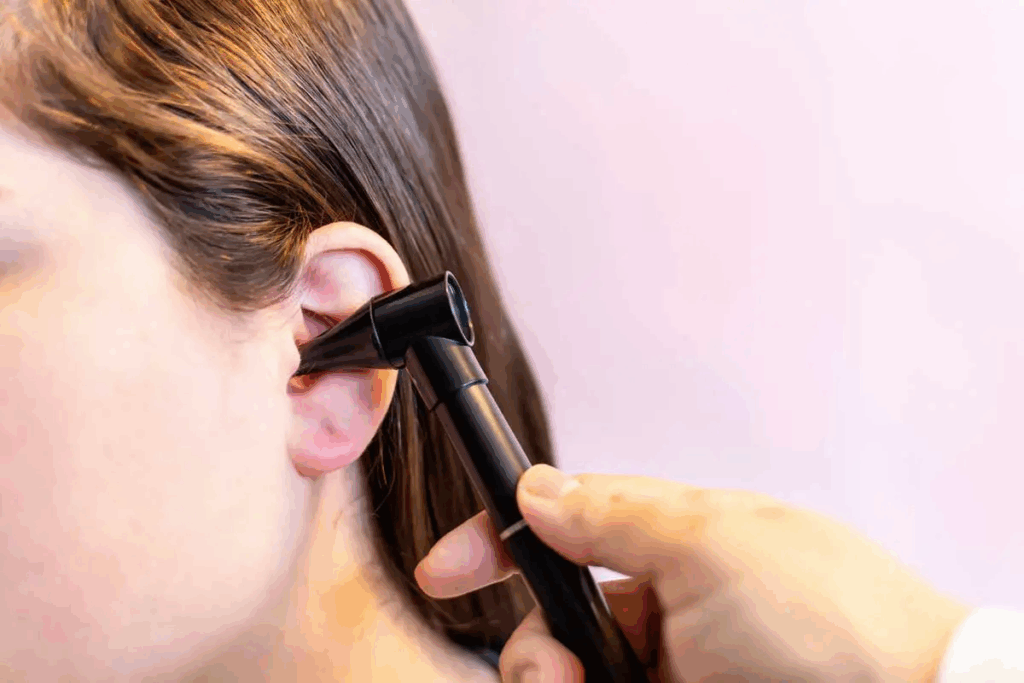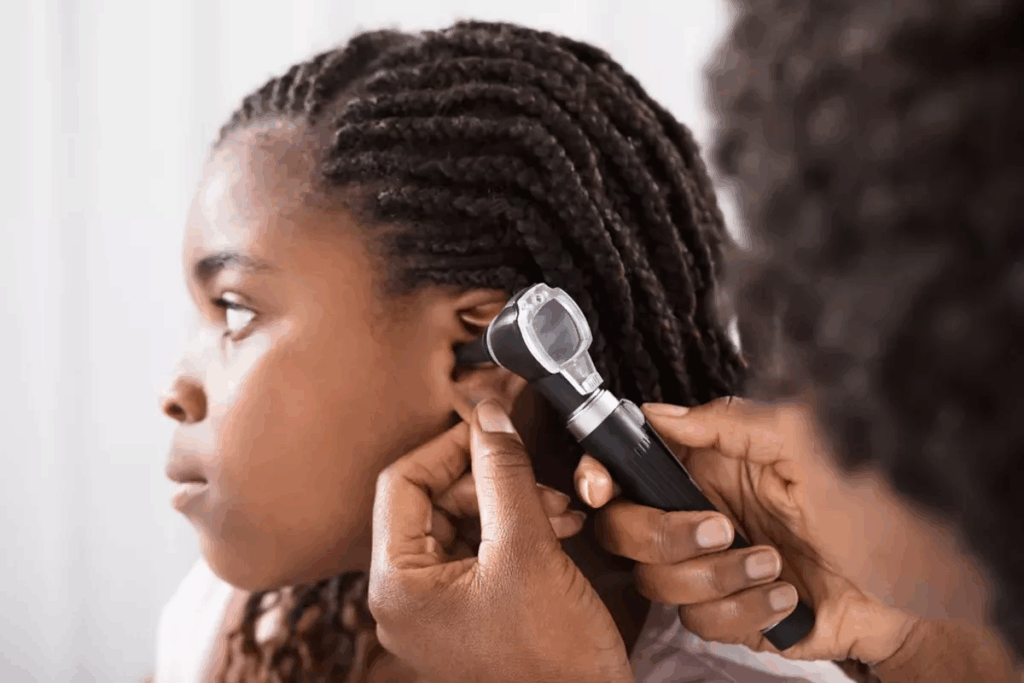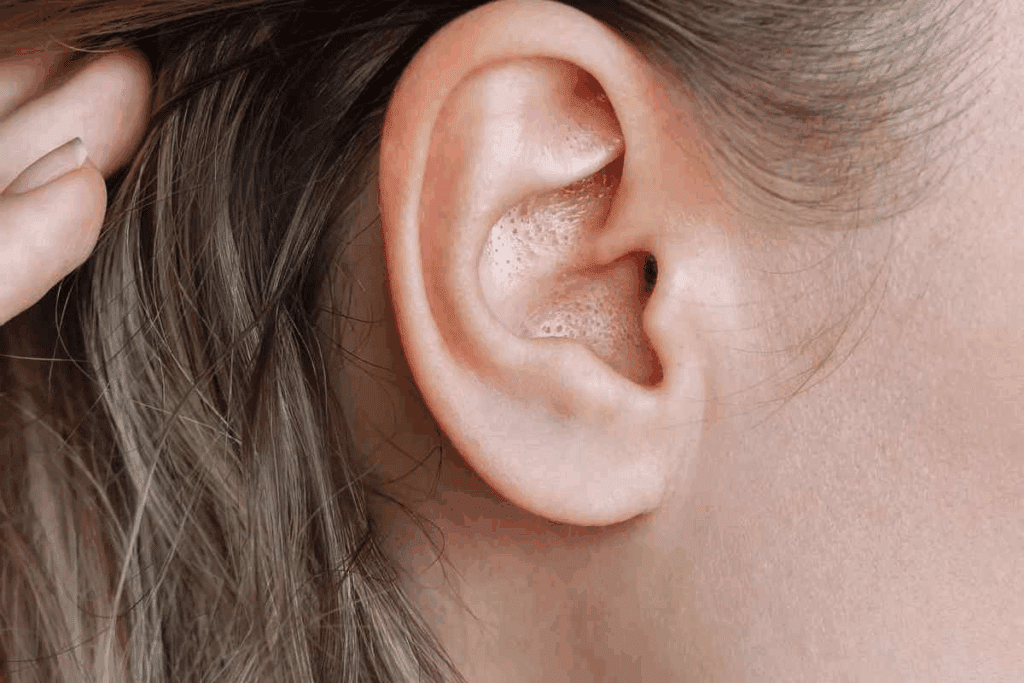
How to tell if a common cold and ear infection are related and when to suspect a cold has progressed to otitis media.
Are you feeling uncomfortable or having trouble hearing? Otitis media, or a middle ear infection, happens when an infection forms behind the eardrum.
At Liv Hospital, we know how important it is to spot the signs of a middle ear infection. This condition can cause serious problems if not treated. It’s key to notice signs like redness and swelling of the eardrum to get the right medical help.
Knowing about middle ear infections and their symptoms is essential for quick diagnosis and treatment. Our team focuses on caring for you, giving compassionate care and proven treatment plans.

Otitis media is when the middle ear gets inflamed or infected. It happens in both kids and adults. The middle ear is behind the eardrum. An infection here can be very painful and might lead to serious problems if not treated right.
About 80 percent of all children will get otitis media at some point. This infection is usually caused by a virus or bacteria. Most kids have at least one by the time they are 3 years old. Adults can also get it.
Otitis media is when the middle ear gets infected. This is often because of bacteria or viruses. The infection can cause pain, hearing loss, and other symptoms. Knowing what otitis media is helps you recognize the signs and get the right medical care.
There are different kinds of middle ear infections. A middle ear infection with purulent fluid is called Acute Purulent Otitis Media (APOM). Other types include serous otitis media and chronic otitis media.
Type of Infection | Characteristics | Common Symptoms |
Acute Purulent Otitis Media (APOM) | Purulent fluid behind the eardrum, often due to bacterial infection | Severe ear pain, fever, hearing loss |
Serous Otitis Media | Fluid accumulation without signs of acute infection | Mild hearing loss, feeling of fullness in the ear |
Chronic Otitis Media | Ongoing or recurrent infections | Recurrent ear pain, persistent hearing loss |
APOM is when you have purulent fluid behind your eardrum, usually from a bacterial infection. Symptoms include severe ear pain, fever, and hearing loss. You need to see a doctor quickly to treat APOM and avoid serious problems.
It’s important to know about the different middle ear infections and their signs. If you think you or your child has an ear infection, see a doctor right away. They can help figure out what’s wrong and treat it.

Middle ear infections often follow a common cold. This shows a strong link between upper respiratory infections and ear health. Knowing this connection is key for prevention and treatment.
The Eustachian tube is important for ear health. It helps regulate air pressure in the middle ear. When a cold hits, the Eustachian tube swells and blocks. This blockage causes mucus to build up in the middle ear, creating a perfect spot for bacteria or viruses to grow and cause an infection.
The Role of the Eustachian Tube
A cold virus infects the upper respiratory tract first. This infection spreads to the Eustachian tube, causing inflammation and blockage. As a result, mucus builds up in the middle ear, raising the risk of an ear infection.
“The connection between upper respiratory infections and middle ear infections is well-established, with the Eustachian tube being a key factor in this relationship.”
The process can be broken down into several stages:
Ear symptoms can show up a few days to a couple of weeks after a cold. The exact time depends on the cold’s severity and the person’s health.
Days After Cold Onset | Possible Ear Symptoms |
3-5 days | Ear fullness, mild hearing changes |
5-7 days | Ear pain, increased hearing loss |
7-14 days | Fever, persistent ear pain, discharge |
Spotting middle ear infection signs early can help get medical help quickly. This can lower the risk of serious problems.
Knowing the risk factors helps us prevent middle ear infections. By understanding these, we can take steps to avoid getting them.
Children aged 6 months to 2 years are at high risk. Their eustachian tubes are small and can easily get blocked. As kids grow, the risk goes down, but other factors can also play a part.
Table: Age-Related Risk Factors for Middle Ear Infections
Age Group | Risk Level | Reason |
6 months – 2 years | High | Small eustachian tubes prone to blockage |
2 – 5 years | Moderate | Eustachian tubes are developing |
5 years and above | Low | Eustachian tubes are less likely to block |
The shape of the eustachian tube is key in ear infections. In kids, these tubes are short and horizontal, making them more likely to get blocked. As we get older, the tubes grow longer and more vertical, making them less likely to block.
“The anatomy of the eustachian tube is a critical factor in the development of otitis media. Its size, shape, and angle can significantly affect the drainage of the middle ear.”
Some environmental and lifestyle factors can raise the risk of ear infections. These include being around tobacco smoke, being in group child care, and bottle feeding. Cutting down on these can help prevent ear infections.
Understanding and tackling these risk factors can help prevent and manage middle ear infections. It’s vital for parents of young children to be aware of these factors. This way, they can take steps to prevent infections and seek medical help when needed.
It’s important to know the early signs of a middle ear infection. This is because middle ear infections can be very uncomfortable. They can also lead to bigger problems if not treated right away.
The first signs of a middle ear infection are often small but shouldn’t be ignored. You might feel ear pain, have a fever, see fluid coming out of your ear, or have trouble hearing. You might also feel like your ear is full or has pressure.
These symptoms can change in how bad they are and can start slowly or quickly. It’s key to notice these signs early, as they mean an infection might be starting. Ear pain is often the first sign, and it can be mild or very bad. Fever is also common, more so in kids.
Children and adults show ear pain in different ways. Kids might get upset, restless, or lose their appetite. They might also pull or tug at their ear. Adults tend to talk more about their pain and might notice hearing loss or a feeling of fullness.
Knowing these differences helps spot ear infections in people of all ages. While kids might not say much, adults can usually explain their symptoms better.
There are ways to check if you might have an ear infection. Try gently pulling on your outer ear. If it hurts, it could be an infection. Also, watch for fever, as it often comes with an infection.
Notice any hearing changes or fluid coming from your ear. If you see these signs, see a doctor right away. They can give you the right diagnosis and treatment.
It’s important to know the signs of an infection behind the eardrum. This can help get medical help quickly. Such infections can cause a lot of discomfort and even serious problems.
Ear pain is a key sign of an infection behind the eardrum. This pain can be mild or very severe. It might feel like there’s pressure or fullness in your ear.
The pain can be sharp, dull, or aching. It might get worse when you lie down or do things that put pressure on your ear, like chewing or yawning.
An infection behind the eardrum can also mess with your hearing. You might notice hearing loss, muffled sounds, or feel like your ear is plugged. This happens because of fluid buildup or inflammation from the infection.
An infection behind the eardrum can also cause fever. A fever means your body is fighting off an infection. If you have a fever, it might mean the infection is more serious and needs doctor’s care.
Fluid coming out of your ear can mean a ruptured eardrum or a bad infection. While it might help with pain and pressure, it shows the infection has gotten worse. The color, consistency, and smell of the fluid can tell a lot about the infection.
Knowing these symptoms is key to treating middle ear infections right. If you or someone you know has these signs, getting medical help is very important. It helps avoid bigger problems and helps you get better faster.
Doctors use an otoscope to check for middle ear infection signs. This tool helps spot important physical signs of the infection.
A red, inflamed eardrum is a key sign of infection. The eardrum gets red and swollen because of the infection. This inflamed red eardrum shows the eardrum is infected.
A bulging eardrum is another sign of infection. Fluid buildup behind the eardrum causes it to bulge. Doctors can see this with an otoscope.
They also check if the eardrum moves well. Normally, it should move with air pressure changes. But with an infection, it doesn’t move as it should because of fluid.
Doctors might see fluid behind the eardrum. This fluid is a sign of an infection of the eardrum or middle ear infection. The fluid makes the eardrum look red and swollen, showing an ear infection eardrum.
Doctors look for these signs to diagnose middle ear infections:
By checking these signs, doctors can accurately diagnose and treat middle ear infections.
Middle ear infections in adults are less common than in kids but can be serious. They can cause a lot of discomfort and health problems if not treated right.
Ear infections in adults can mean there’s a bigger health issue. Unlike kids, adults might get ear infections for different reasons. This could be because of problems with the ear’s shape, immune system issues, or even tumors.
Adults with ear infection symptoms should get checked by a doctor. We’ll talk about the symptoms adults might have and when to get help fast.
Adults with middle ear infections might feel ear pain, hearing loss, fever, and fullness in their ears. They might also talk more about their symptoms, which helps doctors figure out what’s wrong.
If you have severe ear pain, high fever, or hearing loss, see a doctor right away. Also, if you have a weak immune system or were near someone with a bad ear infection, get checked out.
Seeing a doctor quickly can stop bigger problems like mastoiditis or even meningitis in rare cases. Watch your symptoms closely and get help if they’re unusual or severe.
To diagnose middle ear infections, doctors use a mix of clinical checks and special tests. When you see a doctor with ear infection symptoms, they start a detailed check. This is to see if you have an infection and how bad it is.
Doctors mainly use an otoscope for diagnosis. It lets them see inside your ear canal and eardrum. They will put the otoscope in your ear to look at the eardrum.
This check can show signs of infection like redness or fluid. A medical expert says, “The otoscope is key in spotting ear infections. It shows the eardrum and any issues clearly.”
After the otoscope check, your doctor might do more tests. These tests help figure out how serious the infection is and if it’s affecting your hearing. Some tests include:
It’s important to tell middle ear infections apart from other ear problems. Issues like outer ear infections (otitis externa) or Eustachian tube dysfunction can seem like middle ear infections. A detailed check and tests help get the right diagnosis. Doctors say, “Getting the right diagnosis is vital for good treatment and avoiding complications.”
Knowing how doctors confirm middle ear infections helps patients understand the care they get. It also shows why seeing a doctor is important if symptoms don’t get better or get worse.
Managing middle ear infections depends on several factors. We will look at both medical treatments and home remedies. This ensures we cover all bases.
Medical treatments vary based on the infection type and cause. For bacterial infections, antibiotics are often prescribed. It’s important to note that antibiotics only work on bacterial infections, not viral ones.
“Antibiotics should be used judiciously to avoid resistance,” say healthcare professionals. We will discuss when antibiotics are needed and when other treatments are better.
Pain management is key in treating ear infections. Over-the-counter pain relievers like acetaminophen or ibuprofen can help. In some cases, ear drops may be recommended to manage pain and inflammation.
Home remedies can help with middle ear infection symptoms. A warm compress on the affected ear can ease pain. Also, sleeping with your head elevated can help with ear fullness.
Antibiotics are key for bacterial ear infections. But for viral infections, the focus is on symptom management and supporting the body’s healing. We will explain when antibiotics are needed.
In conclusion, treating middle ear infections needs a full approach. This includes both medical treatments and home remedies. Understanding the infection’s cause and severity helps healthcare providers choose the best treatment.
Knowing the signs of middle ear infections is key to getting the right care. Ear infections are common in both kids and adults. By understanding the causes, symptoms, and treatments, we can handle ear infections better.
We’ve talked about how ear infections relate to the common cold, risk factors, and how doctors diagnose them. It’s important to know the early signs and symptoms of an infection behind the eardrum.
In short, knowing about ear infection symptoms and treatments is essential. By learning about treatment options and home care, we can ease symptoms and avoid more problems. If you have ongoing or severe ear infection symptoms, see a doctor.
A middle ear infection, also known as otitis media, is when the middle ear gets infected. This usually happens because of bacteria or viruses.
Symptoms include ear pain, fever, and hearing changes. You might also feel fullness or pressure in your ear. Fluid drainage is another sign.
A cold can cause ear infections by making the middle ear inflamed and filled with fluid. This is because colds affect the upper respiratory system.
Risk factors include age and certain body shapes. Environmental factors like smoke or allergies also play a role.
Kids might cry, fuss, or pull their ears. Adults might say their pain is sharp, dull, or aching.
Doctors look for a red, inflamed eardrum and a bulging one. They also check for reduced mobility and fluid behind the eardrum.
Doctors use an otoscope to check. They might also do more tests to confirm the diagnosis.
Treatments include antibiotics and pain management. Home remedies can also help relieve symptoms.
Seek immediate help if you have severe symptoms. This includes high fever, severe ear pain, or trouble hearing.
Yes, adults can face complications. These include hearing loss or mastoiditis if not treated or if treatment is delayed.
APOM is a middle ear infection with pus or purulent fluid in the middle ear.
You can use over-the-counter pain relievers and warm compresses. Elevating your head can also help.
National Center for Biotechnology Information. (2025). How to Tell if You Have a Middle. Retrieved from https://www.ncbi.nlm.nih.gov/books/NBK470332/>
Subscribe to our e-newsletter to stay informed about the latest innovations in the world of health and exclusive offers!
WhatsApp us